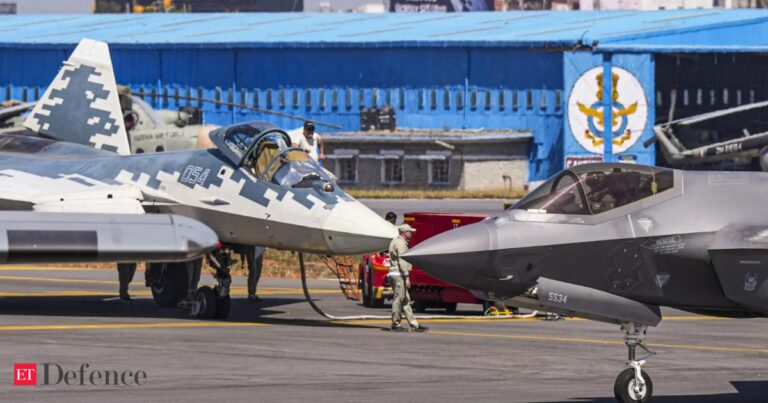F-35 Lightning II
Developed by Lockheed Martin, the F-35 is a single-engine single-seat stealth multi-roll fighter. There are three variations. The US Air Force F-35A, the US Marine Corps F-35B, and the US Navy F-35C. Key specifications include a top speed of Mach 1.6, combat range of approximately 1,500 km, and advanced stealth capabilities. Lockheed Martin said, “The F-35A offers a critical advantage to battleships, offering asymmetrical advantages across the multi-domain spectrum. The conversion capabilities of the F-35A allow pilots to operate in any environment. can.”
Sukhoi Su-57
Developed by Skoy of Russia, the SU-57 is a twin engine, a fifth-generation stealth multi-roll fighter. With a top speed of the Mach 2 and a combat range of approximately 1,900 km, it is designed for aviation advantages and strike missions. The SU-57 emphasizes agility and speed. Sukhoi describes the SU-57 as “a deep modernization of SU-27 fighter jets and significantly improves the effectiveness of its involvement in air, land and sea targets.”
Also Read: F-35 Fighter Jet: What is G2G Trading and Why It Is Liked?
Cost considerations
Cost is a major factor. The F-35 is one of the most expensive fighter jets, with each unit between $80 million and $110 million. Its lifetime operating costs are estimated to exceed $1.5 trillion. In contrast, the SU-57 is inexpensive, with an estimated unit cost of between $35 million and $40 million. Russia has advertised the SU-57 as the equivalent of the F-35, claiming it is “significantly cheap.” They also hold a way to ultimately offer the F-35 stealth fighter to India. ”
F-35 vs SU-57: Technical Features
The F-35 boasts the Pratt & Whitney F135, the world’s most powerful engine, and could reach top speeds of the Mach 1.6. It has a fuel capacity of 18,498 pounds and can carry a payload of 8,160 kg. The F-35A’s electronic sensors include an electro-optical distributed aperture system (DAS) and an electro-optical targeting system (EOTS) that enhance situational awareness and precision strike capabilities. The helmet mounted display system is the most sophisticated of its kind, providing all the intelligence and targeting information needed by a pilot.
Meanwhile, the SU-57 uses a Russian Saturn AL-41F1 combustion turbofan engine, reaching top speeds of Mach 1.8. It can hold up to 7.4 tons of weapons, including air-to-air and ground missiles. The SU-57 comes with a sawtooth exhaust nozzle to reduce radar and infrared signatures and comes with advanced onboard radio electronic equipment, including a powerful onboard computer known as the electronic second pilot .
There are currently over 1,000 F-35s operating worldwide, and have been developed with the involvement of nine countries: the US, UK, Italy, Netherlands, Turkey, Canada, Denmark, Norway and Australia. Conversely, Russia was able to produce only the SU-57 since its first flight in 2010, and serial production began in 2022.
Strategic Implications for India
India has long-standing defence ties with Russia, and Russian origin equipment makes up a large part of military weapons. However, the US offer offers an opportunity to diversify Indian defence acquisitions and integrate advanced Western technology. Experts point out that American defenses often have harsh conditions and could cause hesitation on the Indian side.
A Russian representative for Aero India 2025 said, “If India buys Russian jets, there’s no need to worry about sanctions or wait for parts.” The comment refers to potential US sanctions and delays India’s face of the acquisition of American engines.
The F-35 provides India with the opportunity to diversify its defense suppliers. However, there are often conditions for US defense transactions. India is also developing its own 5th generation fighter, Advanced Medium Fighter (AMCA). India’s Foreign Secretary Vikram Mithri said the F-35’s offer was “in the proposal stage.” He added, “I don’t think that the process has yet to begin with when it comes to India’s acquisition of advanced aviation platforms.”
Also Read: India may take the Rafale route to buy us ‘F35 Fighter: Government likely to choose a limited number
Pakistan has opposed the sale of F-35s and has expressed concerns about military imbalances in the region. Pakistan’s Foreign Ministry said, “Pakistan is deeply interested in the planned transfer of advanced military technology to India. Such steps highlight the military imbalances in the region and provide strategic stability. It will undermine.
“Russia has never eschewed the technology transfer,” said Amit Kousish, former financial advisor to Reuters, for the Indian Ministry of Defense acquisition.
“The problem is not to provide the transfer of Russian technology… We will continue to deal with Russia, buy oil, and perhaps some other things, but such a big (defense) ) Transactions can create their own difficulties. à-vis (The) us,” Cowshish said.
India previously worked with Russia on its fifth generation fighter planes, but it retreated. The Indian Air Force currently has 31 squadrons, below the 42 approved strength. The US and India are also discussing other defence transactions, such as Javelin missiles and striker vehicles. Trump and Modi are scheduled to sign a new Defense Partnership Framework this year.


